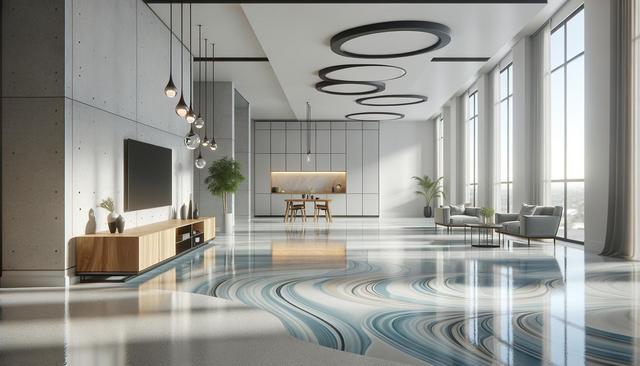What Is Epoxy Flooring and Why Consider It?
Epoxy flooring is a surface coating system made by combining resin and hardeners to create a strong, adhesive compound. Once applied, it forms a durable, glossy finish that bonds securely to concrete and other surfaces. This type of flooring is commonly used in both commercial and residential spaces due to its resistance to wear, chemicals, and moisture. Whether you’re updating a garage, basement, showroom, or kitchen, epoxy offers a versatile solution with a sleek, polished appearance.
The appeal of epoxy lies in its ability to enhance both function and aesthetics. It’s available in a wide range of textures, colors, and finishes, including metallic, flake, and quartz options. These features make it possible to customize your flooring to reflect your personal style or brand image in a commercial setting. Additionally, epoxy’s seamless surface is easy to clean and maintain, reducing upkeep costs over time.
Unlike traditional flooring materials like tile or hardwood, epoxy is seamless and non-porous, which prevents dirt and bacteria from seeping in. This makes it an ideal option for areas that require high hygiene standards, such as medical facilities, food preparation areas, and garages.
Durability That Supports Everyday Use
One of the most significant benefits of epoxy flooring is its exceptional durability. When properly installed, epoxy coatings can withstand heavy foot traffic, impacts, and abrasions, making them suitable for both residential and industrial use. This is particularly advantageous in settings where floors take a lot of abuse, such as garages, warehouses, or workshops. Additionally, epoxy resists damage from chemicals, oil stains, and water, which enhances its longevity.
Key durability features of epoxy flooring include:
- Resistance to chemical spills and oil leaks
- Impact and abrasion resistance
- Moisture protection
- UV and heat resistance (when appropriately formulated)
This type of flooring is especially useful in areas where cleanliness and strength are essential. In homes, epoxy can be a smart solution for laundry rooms, kitchens, or basements. In commercial spaces, it’s commonly used in automotive service centers, hospitals, and retail stores due to its resilience and ease of maintenance.
Low Maintenance with High Visual Appeal
One of the standout advantages of epoxy flooring is how easy it is to maintain. The glossy, seamless surface repels dust, dirt, and liquids, which means spills can be wiped up quickly without staining. This makes it a practical solution for families, pet owners, or businesses with high foot traffic. Unlike carpet or grout-filled tile, epoxy doesn’t trap allergens, making it a more hygienic option as well.
From a design standpoint, epoxy offers numerous customization options. You can choose from a variety of finishes, including:
- Solid colors for a clean, modern look
- Metallic finishes for a high-end aesthetic
- Decorative flakes or quartz for added texture and traction
This makes epoxy flooring suitable for enhancing both the style and function of your interior. Whether you want a bold showroom finish or a subtle, professional tone, epoxy can be tailored to meet your vision. Additionally, the reflective surface of epoxy can help brighten up dark rooms by improving light distribution.
Eco-Friendly and Cost-Effective
Epoxy flooring is not only strong and stylish—it can also be a more environmentally conscious choice compared to certain traditional flooring materials. Its longevity means fewer replacements over time, reducing waste. Moreover, many epoxy products today are formulated with low or no volatile organic compounds (VOCs), minimizing harmful emissions during installation.
In terms of value, epoxy flooring provides a competitive cost-to-benefit ratio. While the initial installation may seem higher than some conventional options, the long-term savings make it worthwhile. Benefits that contribute to cost-efficiency include:
- Minimal maintenance costs
- Long-lasting performance
- Resistance to costly damage (e.g., water or impact)
- Reduced need for cleaning supplies and treatments
Whether you’re a homeowner looking to invest in your property or a business aiming to reduce operational expenses, epoxy can offer a practical and dependable flooring solution.
Where and How to Install Epoxy Flooring
Epoxy flooring can be installed in a variety of settings, including residential, commercial, and industrial spaces. Common application areas include garages, basements, kitchens, showrooms, warehouses, and even offices. The key to a successful installation lies in proper surface preparation—concrete must be clean, dry, and free of cracks or damage before applying the epoxy coating.
Though some DIY kits are available, professional installation is often recommended, especially for larger or high-usage areas. Professionals can ensure even application, proper curing, and optimal bonding to the substrate. The process typically involves the following steps:
- Surface cleaning and preparation
- Crack and hole repairs
- Primer application
- Epoxy coating(s) application
- Optional topcoat for added protection
Depending on the type and thickness of the epoxy system, curing time can range from 24 to 72 hours. Once cured, the floor is ready for regular use and will offer years of dependable service. It’s important to follow the manufacturer’s maintenance guidelines to maximize the life and performance of your epoxy floor.
Conclusion: A Smart Investment for Any Space
Epoxy flooring is a practical and visually appealing way to upgrade nearly any space. Its combination of durability, customization options, and low maintenance makes it suitable for both homes and businesses. Whether you’re renovating a garage, updating a commercial showroom, or simply seeking a longer-lasting flooring solution, epoxy offers a reliable and attractive option. Thoughtful planning and professional installation can help you make the most of this versatile material, ensuring your floors are both functional and visually engaging for years to come.




Leave a Reply